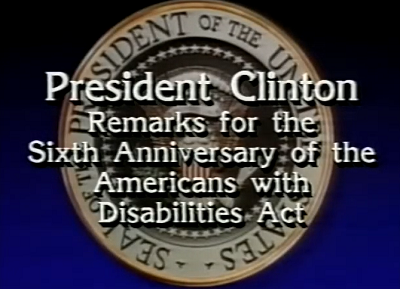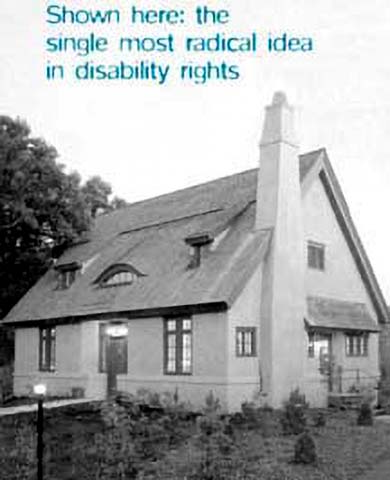The 1990s – Explosion of Community Housing, Institution-Free States
A Home of Your Own, Expanding Family Support
In the 1990s, the impact of the Home and Community Based Waiver and the Community Supportive Living Arrangements really mushroomed.
In 1988, the US Senate and House held hearings on the Americans with Disabilities Act (ADA). Two years later, on July 26, 1990, the ADA was signed into law.
The ADA extended all civil rights protections to people with disabilities and required states to provide services in the "most integrated setting appropriate."
The ADA was applied in the United States Supreme Court decision, Olmstead v L.C. and E.W. and required states to place people with developmental disabilities in communities instead of institutions, with some significant limitations on that requirement.

President George H. W. Bush signs the Americans with Disablilites Act
Moments in Disability History
"Lowell P. Weicker, Jr., Original 'Father' of the Americans with Disabilities Act"
S.933 – Americans with Disabilities Act – 101st Congress"
From the Least Restrictive Environment (LRE) Through the ADA Title II to the Most Integrated Setting
Video: The Oprah Winfrey Show: Electroshock Therapy for Children with Disabilities (1993)
Critics of electroshock state it is barbaric, inhumane, and torture. Two mothers with children with aggressive and self injurious behaviors state they tried everything they could think of but chose electroshock as a last resort and part of a treatment plan – a "miracle."
Another mother can relate but emphasizes this is not a good parent vs. bad parent issue; it's knowing the difference between good supports and bad supports – pain teaches pain.
Dr. Anne Donnellan, author of Progress without Punishment, speaks to research findings stating that electroshock doesn't work and followup studies showing that behaviors return and are increased. In this 1993 episode of The Oprah Winfrey Show, the controversy is aired.
NOTE: On March 6, 2020, the Food and Drug Administration issued a Final Rule banning the use of electric shock devices for self-injurious and aggressive behaviors. The Judge Rotenberg Center in Canton, MA is the only facility that uses these devices. The Center has been the subject of legislation, lawsuits, petitions, and reports for decades that describe electric shock as torture. https://www.nytimes.com
Class Action Lawsuits
The 1990s also saw a growing number of class action lawsuits involving self advocacy (especially People First) groups as plaintiffs, co-plaintiffs, and plaintiff-intervenors.
These suits focused on the same issues as those dating back to the 1970s – abuse and neglect, inhumane living conditions and civil rights violations. The continued outcomes of lawsuits since the 1970s made it clear that even after decades of "improving the institutions" they continued to violate the basic rights of people.
In the 1990s, a new phenomenon occurred – a growing list of states operated no large state institutions for people with developmental disabilities.
- 1991: New Hampshire becomes the first state
to close all of its large institutions. - 1993: Vermont
- 1994: Rhode Island and D.C.
- 1997: New Mexico and Alaska
- 1998: Maine and West Virginia
- 1999: Hawaii
Large Facilities Close
All together, 91 large facilities closed in the United States in the 1990s. All but 12 states had closed at least some of their institutions by the end of 2004 – Arkansas, Delaware, Idaho, Iowa, Louisiana, Mississippi, Nebraska, Nevada, South Carolina, Utah, Wisconsin and Wyoming.
The rate of institution closure reached its highest ever level in the period 1992 to 1995. An average of 12.5 institutions closed each year. That average declined to 6 closures per year between 1996 and 2003.
In the 1990s, the development of more and smaller community living facilities increased dramatically. For instance, by 2002, there were about 118,000 settings for one to six people.
This was almost triple the number available in 1992. The number of residences from between seven and fifteen people remained about the same, and the number of larger facilities (16 people or more) decreased.
On the one hand, the availability of community alternatives increased dramatically, and at the same time, waiting lists remained long. One of the reasons for the dramatic growth in community alternatives were additional changes to the Medicaid waiver rules.
Personal Stories of Living in the Community by People Who Once Lived in Oklahoma's Institutions
Don's Story Warren's Story

In 1993, the Health Care Financing Administration (now called the Centers for Medicare and Medicaid Services or CMS) only required states to demonstrate that the total expenditures for a waiver program would not exceed the cost of serving an equivalent group of people in an institution.
In 1990, Medicaid spent $3.9 billion for home-and-community-based care (for all populations). That represented 13% of the Medicaid long term care spending. By 2000, the total amount was more than four times greater ($18.2 billion) and 27% of the long-term care spending.
Even in the context of these improvements, by the end of the decade, the idea of community living remained controversial. So much so that the Center on Human Policy felt compelled to reissue The Community Imperative.
Today, 21 years after The Community Imperative was written, deinstitutionalization and inclusion remain controversial in some states and localities.
Current debates and controversies surrounding community living obscure fundamental disagreements over values and beliefs between those who support and those who oppose inclusion.
ADA: Back To The Future with U.S. District Court Judge Donovan W. Frank
The Center on Human Policy believes that it is necessary to focus attention on the principles underlying community inclusion.
In terms of human rights:
- All people have basic human and legal rights
- These rights must not be taken away just because a person has a mental or physical disability
- Included in these basic rights is the right to live in the community
In terms of education and support services:
- All people are valuable
- All people have strength and abilities
- All people have the right to services in their lives that support these strengths and abilities
- These supports are best provided in the community
So: To meet basic human rights and get the best services, all people, no matter what their abilities, have the right to live in the community.



